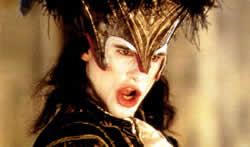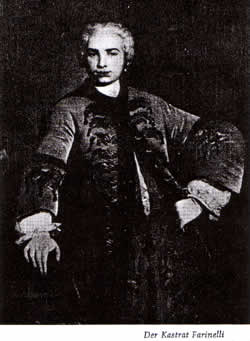Farinelli
Il Castrato (1994), film director Gérard Corbiau,
musical director Christophe Rousset

Johann Adolf Hasse (1699-1783) and Riccardo Broschi (1698-1756), Ataserse (1734)
Arbace's passionate bravura aria from Hasse's Italian pasticcio opera Ataserse, inserted by Farinelli's brother and favourite composer Riccardo Broschi into Pietro Metastasio's text, a splendid example of the type of da capo aria that Baroque composers of opera seria wrote as highlights for castratos to draw the crowds. They were commissioned by the managers of opera houses, although the exorbitant fees paid to castratos such as Farinelli and Senesino, in Italy as well as England, put a heavy strain on theatre budgets.
As women were not generally allowed to take part in the singing of religious services nor even in opera, soprano voices and female roles had to be sung by boys. And, as the boys' voices broke at puberty and the chapels had constantly to recruit and train new ones, some boys were sexually mutilated as a solution to the problem. The practice originated in sixteenth-century Spain and was adopted in the Vatican, for the Sistine Chapel. The Baroque love of artificiality and extreme contrasts explains the rising popularity of castratos all over Europe, who increasingly sung not only the traditional female parts, but also those of heroic males (Ataxerxes, Rinaldo, David, Caesar, Rodomantes, Orlando, etc).
Small wonder that poor Italian families or orphanages dreamed of having their gifted boys castrated as a promising means of income.
The musical training of a castrato was long, thorough, and expensive. Besides singing, he had to study counterpoint and composition, and was apprenticed to the violin, organ, harpsichord, or other musical instruments. This enabled him to extemporize on stage and to improvise the ornamentations so as never to repeat the da capo of an aria with the same studied musical setting, thus creating deliberate contrasts. The long duration of the melismatic singing should not blind us to the fact that the texts of such arias were extremely short, rarely exceeding six lines. The arias were generally passionate, expressing rage, despair, love, jealousy, or contempt, according to the theories of Baroque Affektenlehren. A prime example is Arbace's Son qual nave ch'agitata (I am like a ship on an agitated sea). Cf. Lucy Lockit's jealousy aria "I'm like a skiff on the ocean toss'd" in Johann Christoph Pepusch's and John Gay's parody The Beggar's Opera (1728).
These factors made it possible to transplant brilliant arias from one opera to another (pasticcio), not only by one composer within his own work. On the stage, Carlo Broschi alias Farinelli (1705-1782) may well have sung (and varied) an aria that his brother Riccardo inserted into an opera by Handel or Hasse.
The pasticcio Ataserse was performed at the King's Theatre, Haymarket, built by Sir John Vanbrugh in 1704-05 as The Queen's [Anne's] Theatre, the home of eighteenth-century Italian opera seria.
